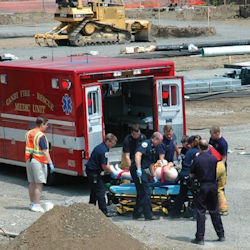Develop a Fall Protection ERP
Train on-site responders: An effective emergency-response plan ensures that on-site responders know emergency procedures, know how to use available rescue equipment, and - if necessary - know how to contact off-site responders.
Workers who use personal fall-arrest systems and who work alone must know how to rescue themselves. Those who work at a remote site may need a higher level of emergency training than those who work near a trauma center or a fire department.
Establish a chain of command: All workers must know their roles and responsibilities during an emergency. A chain of command links one person with overall responsibility for managing an emergency to those responsible for carrying out specific emergency-response tasks. Make sure that back-up personnel can take over when primary responders aren't available.
Establish procedures for responding to emergencies: Procedures are instructions for accomplishing specific tasks. Emergency procedures are important because they tell workers exactly what to do to ensure their safety during an emergency. Your emergency-response plan should include the following procedures - preferably in writing - that describe what people must know and do to ensure that a fallen worker receives prompt attention:
- How to report an emergency.
- How to rescue a suspended worker.
- How to provide first aid.
After an emergency, review the procedures; determine if they should be changed to prevent similar events and revise them accordingly.
Knowledge Check Choose the best answer for the question.
9-4. Which of the following links one person with overall responsibility for managing a fall emergency to those responsible for carrying out specific emergency-response tasks?
You forgot to answer the question!

